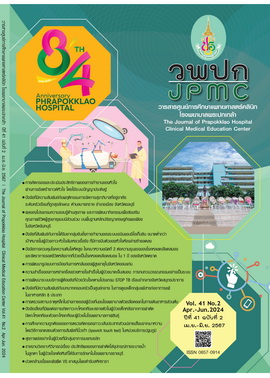Iron Status Assessment among Hospitalized Patients with Acute Upper Gastrointestinal Bleeding
Main Article Content
Abstract
BACKGROUND: Data on iron status assessment and iron deficiency anemia (IDA) prevalence in acute upper gastrointestinal bleeding (UGIB) are limited.
OBJECTIVES: In this study, we aimed to investigate iron status assessment and prevalence of IDA and its associated factors in patients with anemia hospitalized for acute UGIB.
METHODS: We retrospectively reviewed the medical records of patients with endoscopically confirmed UGIB who were admitted between January 2016 and December 2019 and presented with anemia upon admission. The outcomes were iron status measurement and IDA incidence. A logistic regression model was used to determine the factors affecting outcomes.
RESULTS: Among the 867 patients, 180 (20.8%) were evaluated for iron status. Of these patients, 108 (60.0%) had IDA. Factors of iron status assessment were ischemic heart disease (adjusted odds ratio [aOR] 3.88, p=0.001), non-steroidal anti-inflammatory drug use (aOR 1.56, p=0.03), traditional medicine use (aOR 2.84; p=0.01), and mean corpuscular volume (MCV) <80 fL (aOR 1.52, p=0.03), however, older age (aOR increased 0.984 for every 1 year; p=0.01), variceal bleeding (aOR 0.14; p<0.001) and AIMS65 score >2 (aOR 0.69, p=0.002) were intervening factors for iron status assessment. Female sex (aOR 2.69, p=0.05) and MCV <80 fL (aOR 2.00, p=0.04) were independent risk factors for IDA, but diabetes mellitus was a protective factor for IDA (aOR 0.32, p=0.001).
CONCLUSIONS: Iron status assessment among patients with acute UGIB and anemia was low, while the incidence of IDA was high. Our results indicate the importance of evaluating iron status and factors associated with IDA to improve the management of anemia secondary to acute UGIB.
ClinicalTrials.gov Identifier, NCT06299007
Article Details

This work is licensed under a Creative Commons Attribution-NonCommercial-NoDerivatives 4.0 International License.
References
Cotter J, Baldaia C, Ferreira M, Macedo G, Pedroto I. Diagnosis and treatment of iron-deficiency anemia in gastrointestinal bleeding: a systematic review. World J Gastroenterol 2020;26:7242-57.
Planella de Rubinat M, Teixidó Amorós M, Ballester Clau R, Trujillano Cabello J, Ibarz Escuer M, Reñé Espinet JM. Incidence and predictive factors of iron deficiency anemia after acute non-variceal upper gastrointestinal bleeding without portal hypertension. Gastroenterol Hepatol 2015;38:525-33.
Kulnigg S, Stoinov S, Simanenkov V, Dudar LV, Karnafel W, Garcia LC, et al. A novel intravenous iron formulation for treatment of anemia in inflammatory bowel disease: the ferric carboxymaltose (FERINJECT) randomized controlled trial. Am J Gastroenterol 2008;103:1182-92.
Rockall TA, Logan RF, Devlin HB, Northfield TC. Risk assessment after acute upper gastrointestinal haemorrhage. Gut 1996;38:316-21.
Stein J, Connor S, Virgin G, Ong DE, Pereyra L. Anemia and iron deficiency in gastrointestinal and liver conditions. World J Gastroenterol 2016;22:7908-25.
Mak LY, Lau CW, Hui YT, Ng C, Shan E, Li MK, et al. Joint recommendations on management of anaemia in patients with gastrointestinal bleeding in Hong Kong. Hong Kong Med J 2018;24:416-22.
Laine L, Barkun AN, Saltzman JR, Martel M, Leontiadis GI. ACG clinical guideline: upper gastrointestinal and ulcer bleeding. Am J Gastroenterol 2021;116:899-917.
Barkun AN, Almadi M, Kuipers EJ, Laine L, Sung J, Tse F, et al. Management of nonvariceal upper gastrointestinal bleeding: guideline recommendations from the international consensus group. Ann Intern Med 2019;171:805-22.
Chang A, Ouejiaraphant C, Akarapatima K, Rattanasupa A, Prachayakul V. Prospective comparison of the AIMS65 score, Glasgow-Blatchford score, and Rockall score for predicting clinical outcomes in patients with variceal and nonvariceal upper gastrointestinal bleeding. Clin Endosc 2021;54:211-21.
Blatchford O, Murray WR, Blatchford M. A risk score to predict need for treatment for upper-gastrointestinal haemorrhage. Lancet 2000;356:1318-21.
Saltzman JR, Tabak YP, Hyett BH, Sun X, Travis AC, Johannes RS. A simple risk score accurately predicts in-hospital mortality, length of stay, and cost in acute upper GI bleeding. Gastrointest Endosc 2011;74:1215-24.
Lopez A, Cacoub P, Macdougall IC, Peyrin-Biroulet L. Iron deficiency anaemia. Lancet 2016;387:907-16.
El-Halabi MM, Green MS, Jones C, Salyers WJ Jr. Under-diagnosing and under-treating iron deficiency in hospitalized patients with gastrointestinal bleeding. World J Gastrointest Pharmacol Ther 2016;7:139-44.
Chang A, Rugivarodom M, Pungpipattrakul N, Akarapatima K, Suwanno K, Rattanasupar A, et al. Role of oral iron supplementation for anemia secondary to acute nonvariceal upper gastrointestinal bleeding: a randomized controlled trial. J Gastroenterol Hepatol 2023;38:1283-91.
Bager P, Dahlerup JF. Randomised clinical trial: oral vs. intravenous iron after upper gastrointestinal haemorrhage--a placebo-controlled study. Aliment Pharmacol Ther 2014;39:176-87.
Mc Quilten ZK, Thao LTP, Pasricha SR, Artz AS, Bailey M, Chan AT, et al. Effect of low-dose aspirin versus placebo on incidence of anemia in the elderly: a secondary analysis of the aspirin in reducing events in the elderly trial. Ann Intern Med 2023;176:913-21.
Tielleman T, Bujanda D, Cryer B. epidemiology and risk factors for upper gastrointestinal bleeding. Gastrointest Endosc Clin N Am 2015;25:415-28.
Ahsberg K, Höglund P, Kim WH, von Holstein CS. Impact of aspirin, NSAIDs, warfarin, corticosteroids and SSRIs on the site and outcome of non-variceal upper and lower gastrointestinal bleeding. Scand J Gastroenterol 2010;45:1404-15.
Lee MW, Katz PO. Nonsteroidal antiinflammatory drugs, anticoagulation, and upper gastrointestinal bleeding. Clin Geriatr Med 2021;37:31-42.
Tomasević R, Gluvić Z, Mijač D,Sokić-Milutinović A, Lukić S, Milosavljević T. Anemia as a problem: GEH approach. Dig Dis 2022;40:133-41.
Johnson-Wimbley TD, Graham DY. Diagnosis and management of iron deficiency anemia in the 21st century. Therap Adv Gastroenterol 2011;4:177-84.
Joosten E, Dereymaeker L, Pelemans W, Hiele M. Significance of a low serum ferritin level in elderly in-patients. Postgrad Med J 1993;69:397-400.
Thandassery RB, Sharma M, John AK, Al-Ejji KM, Wani H, Sultan K, et al. Clinical application of AIMS65 scores to predict outcomes in patients with upper gastrointestinal hemorrhage. Clin Endosc 2015;48:380-4.
Saito H. Metabolism of iron stores. Nagoya J Med Sci 2014;76:235-54.
Soliman AT, De Sanctis V, Yassin M, Soliman N. Iron deficiency anemia and glucose metabolism. Acta Biomed 2017;88:112-8.
Pradeepa R, Shreya L, Anjana RM, Jebarani S, Kamal Raj N, Kumar MS, et al. Frequency of iron deficiency anemia in type 2 diabetes-Insights from tertiary diabetes care centres across India. Diabetes Metab Syndr [Internet]. 2022 [cited 2023 Nov 15];16(11):102632. Available from: https://www.sciencedirect.com/science/article/abs/pii/S1871402122002466?via%3Dihub
